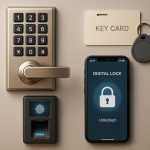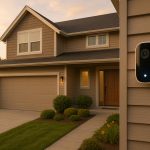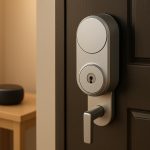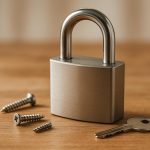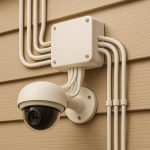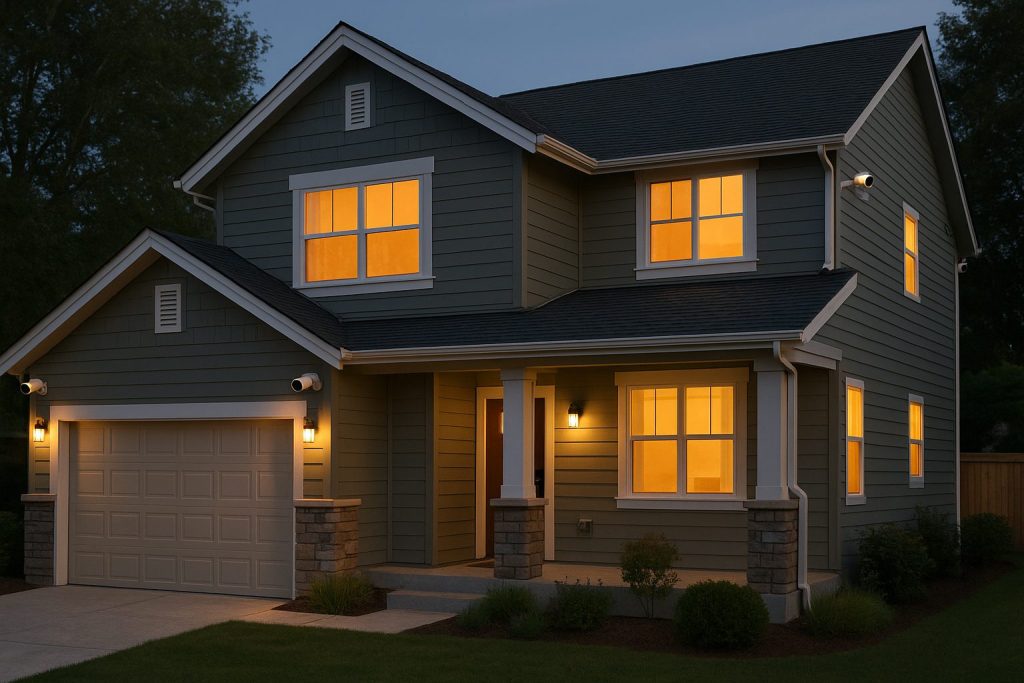Your home’s security is only as strong as its weakest link. Regular assessments help you spot vulnerabilities like broken locks, poor lighting, or overgrown shrubs that could make your property an easy target. Here’s a quick rundown of what to check:
- Doors: Use solid materials like steel or wood and install strong deadbolts or multipoint locks.
- Windows: Ensure locks work properly and add security film or stops for extra protection.
- Lighting: Use motion-sensor LED lights to brighten dark areas around your property.
- Yard: Trim bushes, secure outdoor tools, and inspect fences for gaps.
- Interior: Test locks, alarms, and monitoring systems regularly. Upgrade to smart locks or safes for valuables.
- Perimeter: Maintain visibility with proper lighting and landscaping, and secure access points.
Security needs change over time, so reassess regularly – especially after life changes or neighborhood developments. For more complex solutions, professional locksmiths can provide tailored advice and advanced upgrades. Stay proactive to keep your home and loved ones safe.
What Should Be On A Home Security Audit Checklist? – SecurityFirstCorp.com

Checking Your Home’s Exterior Security
After your initial security assessment, it’s time to focus on the exterior of your home – your first line of defense.
Your home’s exterior plays a crucial role in keeping intruders at bay. Carefully inspect doors, windows, lighting, and landscaping to identify any weak points. Make sure to review these areas during both daylight and nighttime to ensure your property is well-protected under all conditions.
Door Security Check
Evaluate the materials of your exterior doors. Reinforced materials like steel, aluminum, solid wood, or fiberglass are much harder to breach and offer stronger protection against forced entry.
Install and maintain high-security deadbolts. These deadbolts are designed to resist picking and bumping, making them a key component of robust door security.
Consider multipoint locking systems. These systems secure the door at multiple points, providing an added layer of protection and significantly strengthening your home’s defenses.
Window Security Review
Inspect all ground-level and easily accessible windows. Check that window locks are functioning properly and look for any wear or damage to the frames. Windows that don’t close securely or have visible gaps could be potential entry points.
Assess visibility and accessibility. Windows that are hidden from view – such as those obscured from the street or neighbors – may benefit from added security measures like window stops or security film. These can deter break-ins while still allowing ventilation.
Outdoor Lighting Check
Check your perimeter lighting after dark. Install motion sensor lights to brighten shadowy areas near doors, windows, and other access points. Replace any burnt-out bulbs to ensure consistent coverage. Motion-activated lights can be a simple yet effective way to discourage intruders.
Opt for energy-efficient LED lighting. LEDs provide reliable illumination without creating a harsh glare, making them a practical choice for outdoor security.
Yard and Hiding Spot Review
Trim overgrown bushes and trees near windows and doors. Keeping vegetation under control eliminates potential hiding spots for intruders and improves visibility around your home.
Secure outdoor items like ladders, furniture, and tools. These can be used by trespassers to gain access to upper levels or hidden areas. Also, inspect your fencing for any gaps or weaknesses that could compromise your property’s security.
For more complex vulnerabilities, Sherlock’s Locksmith offers professional security assessments. Their experts can help you identify potential risks and suggest solutions tailored to your needs. Once your exterior is secure, it’s time to turn your attention to the interior for a comprehensive safety strategy.
Interior Security Review
Once your exterior defenses are in place, take some time to evaluate your interior security. This involves checking locks, alarms, and other measures to ensure your valuables are well-protected. By layering your defenses, you can create a safer home environment.
Interior Lock and Hardware Check
Inspect all interior door locks, especially those securing private spaces. Strong locks add an extra layer of protection beyond your exterior barriers. Make sure bedroom door locks are functioning properly, and consider upgrading to privacy locks with thumb-turn mechanisms. These are particularly useful during emergencies, allowing for quick and easy access.
Evaluate strike plates and door frames. Reinforced strike plates with screws that are at least 3 inches long help anchor the plate securely into the door frame, making it much harder for someone to force entry. Check for loose screws or any damage in the wood surrounding the strike plate, as these can compromise the door’s strength.
Think about upgrading to smart locks for certain rooms. Smart locks let you monitor and control access to specific areas, like a home office or a master bedroom. Many models can send alerts to your phone when a door is opened, providing added peace of mind for spaces housing valuable items.
Maintain door hardware regularly. Test all doorknobs, hinges, and locks monthly to ensure they’re working smoothly. Lubricate moving parts every six months to prevent sticking or unnecessary wear, keeping everything in top condition.
If you’re looking for professional help with advanced lock systems, Sherlock’s Locksmith offers specialized services, including lock upgrades and access control installations tailored to your home’s needs.
Once your locks are secure, the next step is to ensure your alarm and monitoring systems are functioning as they should.
Alarm and Monitoring System Review
Test your alarm system sensors monthly. Open each door and window with a sensor to confirm the system detects the breach and triggers an alert. For wireless sensors, replace batteries as needed – most systems will notify you when battery levels are running low.
Position motion detectors strategically. Sensors should cover critical areas like hallways, staircases, and large rooms without being triggered by pets or routine household movements. Install them in corners at a height of 6-8 feet for the best coverage and to avoid false alarms caused by ceiling fans or heating vents.
Review your monitoring service plan. Monitored systems connect to professional centers that can dispatch emergency services quickly, while unmonitored systems rely on loud sirens and smartphone notifications. Consider factors like how often you travel, neighborhood response times, and your overall lifestyle when deciding which option works best for you.
Check the backup power system. Your alarm system needs to function during power outages. Test the backup battery by unplugging the main control panel to see if the system stays active. Most backup batteries last 4-6 hours and should be replaced every 3-5 years to ensure reliability.
With your alarm system in good shape, it’s time to focus on safeguarding your valuables and managing visibility inside your home.
Protecting Valuables and Managing Interior Visibility
Use window treatments to maintain privacy. Curtains, blinds, or shades can block the view from outside while still letting in natural light. Pay particular attention to windows that face busy streets, sidewalks, or neighboring properties, as these are often the easiest for outsiders to peer through.
Invest in a secure home safe for valuables and documents. A fireproof safe weighing at least 100 pounds is not only harder to steal but also protects its contents from fire damage. If your safe is lighter, bolt it to the floor or hide it in an out-of-sight location such as a closet or basement.
Keep expensive items out of sight. Avoid placing things like large TVs, computers, jewelry, or artwork near windows where they’re visible from outside. Rearrange furniture or adjust lighting to reduce visibility, especially after dark.
Create the illusion of activity at home. Use programmable timers for lamps, TVs, and radios to mimic normal household routines. Change the timing throughout the week to avoid predictable patterns that might tip off potential intruders when the house is empty.
Secure collections and important documents. Items like coin collections, family heirlooms, and irreplaceable papers should be stored in a hidden safe or a bank safety deposit box. For added security, take photos or videos of these valuables for insurance purposes and keep the records stored separately.
sbb-itb-643e28e
Property Perimeter and Neighborhood Security
When it comes to safeguarding your home, don’t just focus on the interior – your property’s perimeter and the surrounding neighborhood play a key role in creating a solid security plan. Securing the outer edges of your property is just as important as reinforcing what’s inside. Two essential elements to keep in mind are outdoor lighting and landscaping that doesn’t offer hiding spots for potential intruders.
Property Visibility and Access Points
Outdoor lighting is a game-changer when it comes to home security. Installing perimeter lights can eliminate shadowy areas and create a well-lit boundary along fences and property lines. This not only makes your home less appealing to intruders but also makes it harder for anyone to sneak around unnoticed. Pairing good lighting with smart landscaping is another layer of protection – trimmed bushes and clear sightlines leave no place for someone to hide.
Community Security Factors
Landscaping isn’t just about curb appeal; it’s also a powerful security tool. Keep vegetation trimmed, especially near windows and entry points, and make sure hedges don’t block visibility. Remove trellises or overhanging branches that could help someone climb into your property. These small adjustments can make a big difference in keeping your home secure.
If you’re in Pittsburgh and want expert advice, Sherlock’s Locksmith provides professional security consultations. They can help you customize your perimeter defenses based on your property’s unique needs.
Mail and Package Protection
Professional Security Services and Ongoing Maintenance
While DIY security checks can be helpful, professional locksmith evaluations take things a step further by identifying hidden vulnerabilities and providing custom solutions. Homeowners might spot obvious issues, but experts are trained to uncover risks specific to your property and neighborhood that might not be immediately apparent.
Why Choose Professional Security Reviews?
Professional locksmiths bring expertise that goes beyond what a DIY review can offer. They stay informed about the latest security threats, understand which lock designs are more susceptible to modern break-in techniques, and use advanced tools to identify weaknesses that are easy to miss.
A thorough professional evaluation typically includes areas that homeowners might overlook. For example, locksmiths assess the structural strength of door frames, check whether your locks meet modern security standards, and identify less obvious access points that could be exploited.
For those in Pittsburgh, Sherlock’s Locksmith provides detailed security consultations for both residential and commercial properties. Their certified technicians evaluate everything from basic locks to sophisticated electronic systems, offering tailored recommendations based on your property’s layout and specific risks.
But professional services don’t stop at assessments. Locksmiths can also handle lock installations and upgrades, rekeying, and integrating advanced security systems. They’re available for emergencies too, such as fixing broken locks or addressing compromised entry points that need immediate attention.
Beyond the initial review, maintaining and updating security measures regularly is essential for long-term protection.
Staying Ahead with Updated Security Measures
Security isn’t static – what worked yesterday might not be enough today. Regular updates ensure your home remains well-protected against evolving threats while taking advantage of advancements in technology.
Advancements in lock technology are frequent. Modern locks now include features like resistance to picking and bumping, smartphone connectivity, temporary access codes, and detailed entry logs – features that older models lack. Upgrading to these newer options can significantly improve your home’s security.
Shifting threats also make periodic reviews essential. Burglary techniques evolve, local crime patterns change, and new vulnerabilities emerge as criminals adapt. The security setup that worked when you first moved in may need adjustments to address current risks and neighborhood trends.
Experts recommend scheduling professional security reviews every two to three years or sooner if there’s an incident or a major change. Events like home renovations, new household members, or changes in occupancy patterns (like a new work schedule) should also trigger a reassessment.
Regular maintenance is just as important as updates. Setting up a maintenance calendar ensures you don’t overlook essential tasks like servicing locks or updating system features. Keeping a record of maintenance history can also be helpful for insurance claims and ensures everyone in the household understands the security setup.
Conclusion: Maintaining Active Home Security
Protecting your home starts with a thorough security risk assessment that addresses vulnerabilities across the exterior, interior, and perimeter. By doing so, you establish a strong, layered defense to safeguard your family and belongings.
This approach combines detailed evaluations of your home’s weak points, ensuring everything from secure doors and windows to proper lighting and alarm systems is accounted for. The goal? To leave no gaps in your home’s security plan.
However, home security isn’t a set-it-and-forget-it solution. As circumstances change – whether it’s new technology, evolving threats, or changes in your property – frequent reassessments are essential. What worked when you moved in may no longer be enough today.
Sometimes, it takes a professional to uncover risks you might miss. For example, Pittsburgh residents can turn to Sherlock’s Locksmith for personalized consultations. Their expertise goes beyond basic lock inspections, offering advanced electronic systems and emergency response strategies tailored to your home.
Investing time and effort into regular self-assessments and professional evaluations ensures your home remains secure against emerging threats. This proactive approach provides peace of mind and keeps your defenses strong.
FAQs
How often should I perform a home security risk assessment to keep my property safe?
Performing a home security risk assessment annually is a smart way to keep your property safe. It’s also important to reevaluate your home’s security whenever significant changes occur – like moving to a new home, upgrading your security system, or after a break-in.
These regular checkups can uncover weak spots and ensure that essentials like locks, doors, windows, and outdoor spaces are properly secured. Taking these proactive steps not only strengthens your home’s defenses but also brings peace of mind for you and your loved ones.
What are the advantages of using smart locks and modern alarm systems instead of traditional security options?
Smart locks and modern alarm systems bring a new level of security to your home with features like tamper alerts, auto-locking, and encryption. These tools make it much more difficult for anyone to gain unauthorized access, giving you peace of mind and boosting overall home safety. Plus, they let you stay in control no matter where you are – allowing you to lock or unlock doors and receive instant alerts remotely.
What’s more, these systems work effortlessly with other smart home devices, creating a seamless security setup. With real-time notifications and automation, they don’t just keep your home safer – they also make your life easier. Compared to older security methods, they offer a blend of protection and convenience that’s hard to beat.
How can hiring a professional security service make my home safer compared to a DIY approach?
Professional security services play a crucial role in improving your home’s safety by tackling weaknesses that DIY approaches often miss. These experts perform detailed risk assessments, suggest customized solutions, and install top-tier equipment designed to keep your home secure.
What sets professional services apart is their 24/7 monitoring and quick response capabilities, ensuring your home is protected at all hours. With their specialized knowledge and advanced tools, they can identify and handle potential risks more effectively, offering you an added sense of security.



